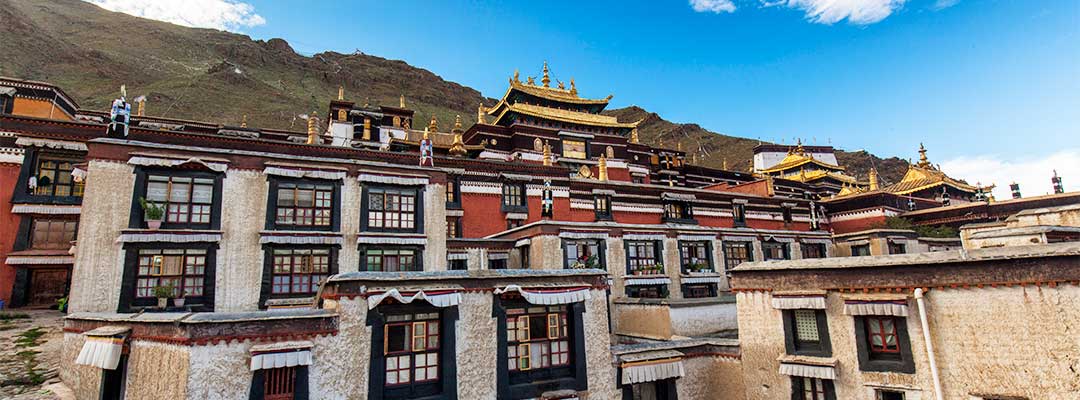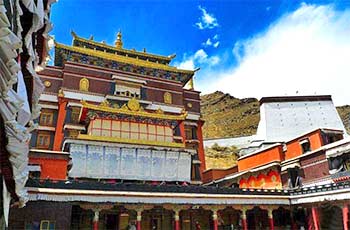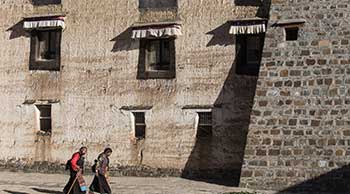Tashilunpo Monastery

Tashilunpo Monastery is the largest monastery of the Gelugpa Sect of Tibetan Buddhism in Tibet. It is one of the six major monasteries of the Gelugpa Sect together with Drepung Monastery, Sera Monastery and Ganden Monastery in Lhasa, Kumbum Monastery in Qinghai and Labrang Lamasery in southern Gansu.
Tashilunpo Monastery was firstly built in 1447AD by Dalai I Gendundrup, disciple of Tsongkhapa, founder of the Gelugpa Sect. It took 12 years to complete. Since Panchen IV, Tashilunpo Monastery has become the domicile of Panchens.
- Chinese name: 扎什伦布寺 Zhā Shén Lún Bù Sì
- Duration: 1 to 2 hours
- Entrance Fee: RMB 55
- Opening hours: 09: 00~17: 00, 12: 00~14: 00 The Buddhist hall is not open to the public.
- Best time to visit: All year round
- Address: No.1 Jijilangka Road, Shigatse City, Tibet Autonomous Region
Highlights of Tashilunpo Monastery
 Tsochin Hall
Tsochin Hall Tsochin Hall
As one of the largest buildings upon entering the monastery, Tsochin Hall is the main hall of Tashilunpo Monastery. Outside the hall is a courtyard surrounded by corridors, which is the lecture field, where in the past Panchen Lamas often preach to all monks, and Lamas reply to religious queries. The front part is the Main Assembly Hall with the throne of Panchen in the center and three Buddhist halls behind the assembly hall. Shakya Muni Hall is situated in the center, Maitreya Hall in the west and Tara Hall in the east.
Great Maitreya Hall
The most magnificent building in the monastery is the Great Maitreya Hall which consists of five stories, with two stories of winding corridors below. The 30m-high hall is made purely of stone. The Buddhist hall features the shape of a ladder which gets narrower as the stairs go higher. At the apex of each floor stands a lion. The hall is decorated with copper pillars and a golden roof, giving out a sense of grandeur. In the center, it enshrines the gilt bronze Jampa Buddha, cast by pan-chen-blo-bzang-chos-kyi-nyi-ma Panchen Lama IX in 1914 (sitting statue of Maitreya Buddha). The 26.2-meter-high Buddha sits on a lotus base of up to 3.8 meter high. It looks solemn and stately. Besides more than 1,400 jewels embedded between the eyebrows, such as diamonds, pearls, amber, corals and pine otoliths, the Buddha consists of a total of 335 kilograms of gold and more than 115,000 kilograms of brass. It is the largest brass Buddha in the world.
Lingta Hall
In the seven Lingta halls to the east of the monastery, there are pagodas of all Panchen Lamas. The most famous one is Jue Gan Xia Palace, where there is Pagoda of Panchen Lama IV built in 1662. The 11-meter-high pagoda has a silver-gold base and silver body, inlaid with jewels and jade. The remains of Panchen Lama IV are stored in it. The pagoda where Panchen Lama V to IV are buried is called “Tashi Nanjie”. Their remains are placed in five separate sandalwood boxes in the treasured vases. A bronze statue of pan-chen-blo-bzang-chos-kyi-nyi-ma--Panchen Lama IV is placed in the middle of the pagoda. The pagoda is 11.52 meters high. Its gold-plated body is decorated with a silver lining and jewels, it is very gorgeous and solemn.
Buddha exhibition platform
The Buddha platform is located in the northeast of Tashilunpo Monastery. It serves as the venue for grand Buddha exhibition activities for three days around May 15 of the Tibetan calendar. Embroidered images of Past Buddha (Buddha of Infinite Light), Present Buddha (Shakya Muni Buddha) and Future Buddha (Jampa Buddha) are exhibited on the 32-meter-high Buddha exhibition platform for monks and religious people to worship and present Hada. The Buddha exhibition platform in Tashilunpo Monastery is unique among all monasteries of the Yellow Sect in Tibet.

Travel Tips
Tashilunpo Monastery is a monastery of Gelugpa Sect. Please respect the local customs and beliefs to follow the law of left-in-right-out and turn the prayer wheel clockwise. No photographing inside the monastery.
Drop us a line and we'll connect you with the top China expert in no time!